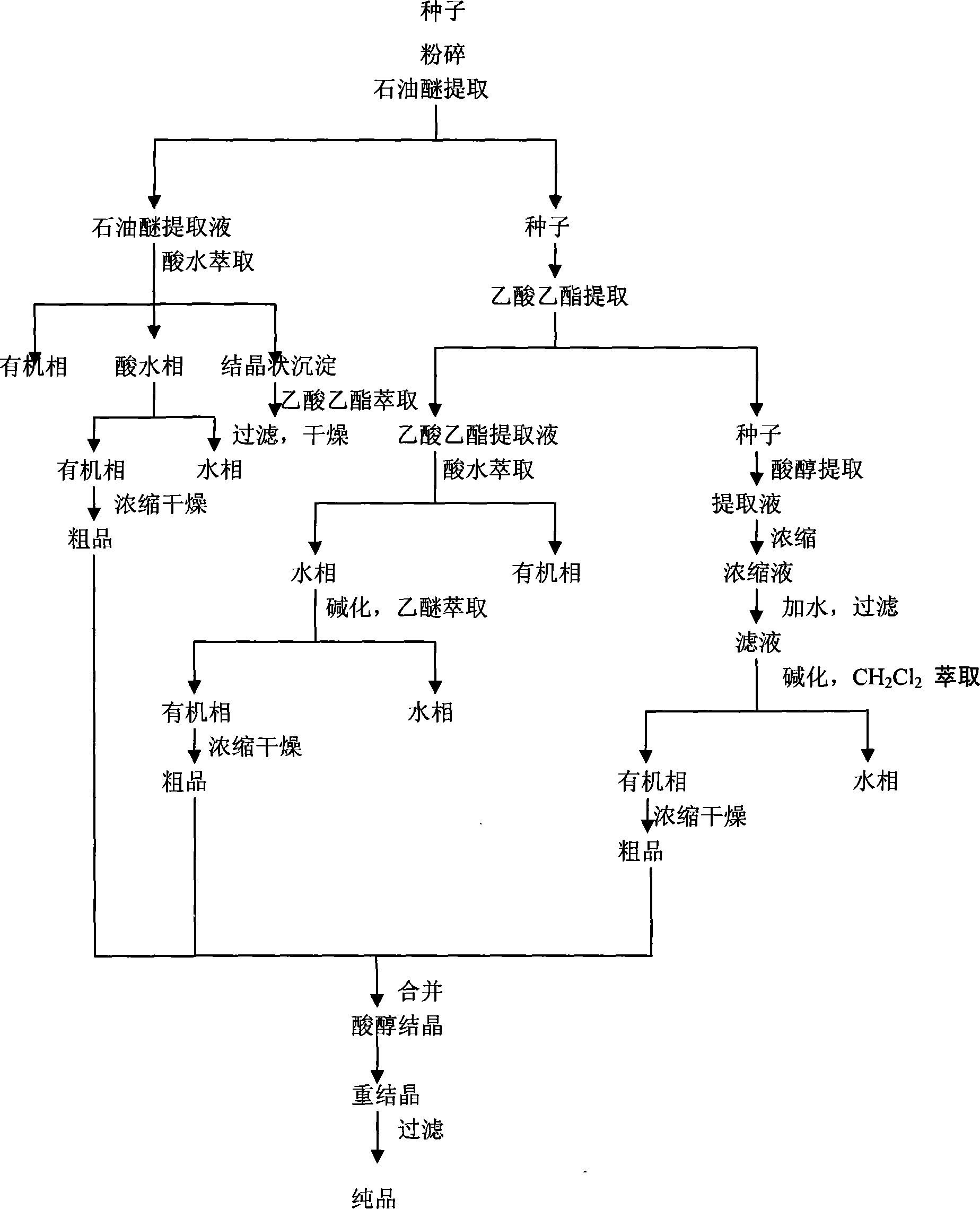Technique for preparing willow leaf tabersonine
A willow-leaf glycyrrhizin and preparation technology, applied in the field of preparation of plant extracts, can solve the problems of long production cycle, low product yield, complicated process, etc., and achieve short production cycle, high product yield, chemical steps simple effect
- Summary
- Abstract
- Description
- Claims
- Application Information
AI Technical Summary
Problems solved by technology
Method used
Image
Examples
Embodiment 1
[0017] A preparation process of willow glycyrrhizine includes the following steps in sequence:
[0018] 1. Raw material pretreatment: The African horse bell fruit is harvested when it is ripe or about to mature, dried, crushed, and dried through a 40-mesh sieve for use;
[0019] 2. Reflux extraction: Take 200 grams of seed powder and extract with 4 times, 3 times, and 3 times the volume of n-hexane at 50°C for three times with 1 hour each time. Filter, combine the filtrate, wash the n-hexane layer three times with 750 ml of a 1% hydrochloric acid aqueous solution by mass, recover the organic solvent, and combine the acid aqueous solution for use;
[0020] 3. Purification on the column: D101 macroporous adsorption resin is selected, the acid water solution is directly loaded, the impurities are washed with water, the product is eluted with ethanol with a mass ratio of 80%, and the eluate is concentrated under reduced pressure to remove the ethanol;
[0021] 4. Alkalization and extr...
Embodiment 2
[0023] A preparation process of willow glycyrrhizine includes the following steps in sequence:
[0024] 1. Raw material pretreatment: African horse bell fruit is harvested when it is ripe or about to mature, dried, crushed, and dried through a 50-mesh sieve for use;
[0025] 2. Reflux extraction: Take 200 grams of seed powder and extract with 4 times, 3 times, and 4 times volume of 80% methanol aqueous solution at 60-70°C under reflux for three times, respectively, for 1 hour, 1.5 hours and 1 hour. Filter, combine the filtrate, concentrate under reduced pressure until there is no alcohol, add 500ml of hydrochloric acid aqueous solution with a mass ratio of 1.5%, and set aside;
[0026] 3. Purification on the column: choose XDA-6 macroporous adsorption resin, directly load the sample with the acid water solution, wash the impurities with water, elute the product with a 90% ethanol aqueous solution by mass, and concentrate the eluate under reduced pressure to remove the ethanol;
[...
Embodiment 3
[0029] A preparation process of willow glycyrrhizine includes the following steps in sequence:
[0030] 1. Raw material pretreatment: African horse bell fruit is harvested when it is ripe or about to mature, dried, crushed, and dried through a 50-mesh sieve for use;
[0031] 2. Reflux extraction: Take 200 grams of seed powder and extract with 3 times, 2.5 times, and 2.5 times volume of 90% ethanol aqueous solution at 70°C for three times, respectively, for 1 hour, 50 minutes and 1 hour. Filter, combine the filtrate, concentrate under reduced pressure until there is no alcohol taste, add 500ml of 0.5% hydrochloric acid aqueous solution by mass, and set aside;
[0032] 3. Purification on the column: use XDA-7 macroporous adsorption resin, directly load the sample with acid water solution, wash impurities with water, elute the product with 60% ethanol, and concentrate the eluate to remove the ethanol;
[0033] 4. Alkalization and extraction: add 200ml of water to the concentrated sol...
PUM
| Property | Measurement | Unit |
|---|---|---|
| melting point | aaaaa | aaaaa |
Abstract
Description
Claims
Application Information
 Login to View More
Login to View More - R&D
- Intellectual Property
- Life Sciences
- Materials
- Tech Scout
- Unparalleled Data Quality
- Higher Quality Content
- 60% Fewer Hallucinations
Browse by: Latest US Patents, China's latest patents, Technical Efficacy Thesaurus, Application Domain, Technology Topic, Popular Technical Reports.
© 2025 PatSnap. All rights reserved.Legal|Privacy policy|Modern Slavery Act Transparency Statement|Sitemap|About US| Contact US: help@patsnap.com


